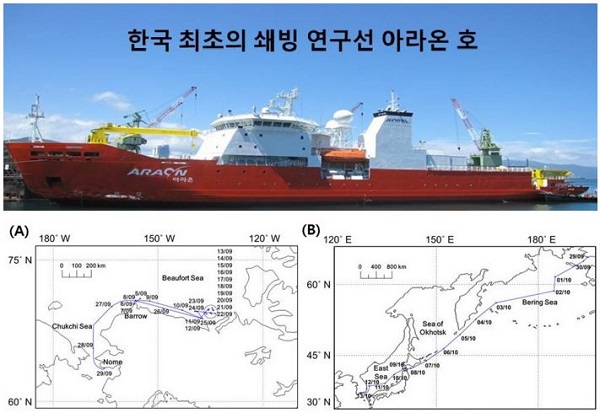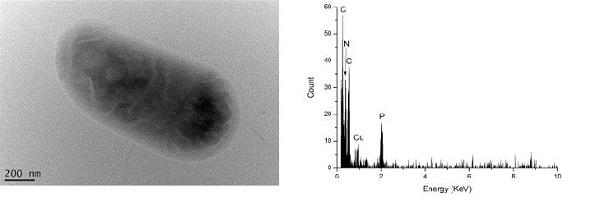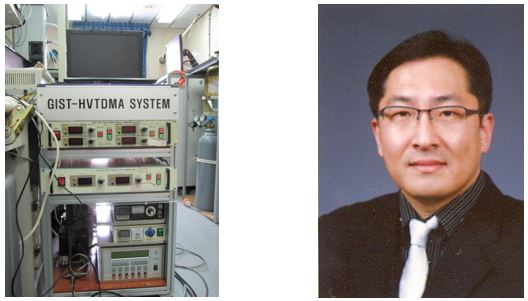Media Center
A multimedia mosaic of moments at GIST
GIST Excellence
[Press release] Research team led by Professor Kihong Park offers new insights into how sub-micrometer particles form over oceans
- 엘리스 리
- REG_DATE : 2015.10.27
- HIT : 785
Research team led by Professor Kihong Park offers
new insights into how sub-micrometer particles form over oceans
The research team used data collected during a nearly 12,000 km voyage by the Korean ice breaker ARAON to understand how sub-micrometer particles are generated overs the oceans. They found that biological activity within the oceans have an effect on the characteristics of the sub-micrometer particles that form over the oceans.

(Figure 1). Distributions of hygroscopic growth factor (HGF) and shrinkage factor (SF) of the size-selected sub-micrometer particles (50 - 220 nm) during cruise 1 (a) and cruise 2 (b) of ARAON. The low HGF mode is mainly attributable to biological organic compounds, which tends to be less hygroscopic. Cruise 1 (a) travelled over a more biologically active part of the ocean than cruise 2.
GIST (Gwangju Institute of Science and Technology) under its Harmful Airborne Particulate Reduction Program has utilized the ARAON ice breaker from the Korean Polar Research Institute (KOPRI) to make continuous measurements of sub-micrometer particles over the Arctic Ocean from Barrow to Nome, Alaska (cruise 1). The ARAON then measured sub-micrometer particles over the Pacific Ocean from Nome to Gwangyang, Korea (cruise 2). From this nearly 12,000 km voyage, the researchers discovered that biological activity within the oceans have a significant effect on the characteristics of the sub-micrometer particles that form over the oceans.
The research team was led by Professor Kihong Park of the School of Environmental Science and Engineering at GIST and by Dr. Young Jun Yoon of the Korean Polar Research Institute. The research was supported by the National Leading Research Laboratory Program of the Ministry of Science, ICT, and Future Planning (MSIP) and the National Research Foundation (NRF) of Korea. This work was also funded by a National Research Foundation of Korea Grant funded by the Korean Government. Their paper entitled "Comparison of hygroscopicity, volatility, and mixing state of submicrometer particles between cruises over the Arctic Ocean and the Pacific Ocean" was published on October 2, 2015, in the online edition of Environmental Science & Technology.
The data for this research was collected by technology developed at GIST called HVTDMA: hygroscopicity and volatility tandem differential mobility analyzer. An aerosol inlet was placed on the front of the ARAON far away from the ship"s exhaust, and researchers used the HVTDMA to characterize the collected sub-micrometer particles. To measure the size distribution of the sub-micrometer particles, a differential mobility particle sizer was used. To measure black carbon, the researchers used an Aethalometer.
The researchers found that concentrations of particle mass and black carbon increased with increasing continental influence from more polluted areas, such as China and Japan. They also found that abundant organic matter resulting from greater biological activity in the ocean contributed to the production of primary biological particles and the release of biological organic compounds. These biological organic compounds can be instrumental in new particle formation and growth, which can have a particularly strong influence on cloud formation over the oceans. Understanding the relationship between these sub-micrometer particles and how they form is important to understanding their direct and indirect effects on global climate.
Sub-micrometer airborne particle research aboard the ARAON
• Sailing period: September 7, 2013 through October 13, 2013• Sailing distance: about 12,000㎞• Sailing Area: Arctic, Pacific, North East Asia, East Coast of Korea• Measuring equipment: hygroscopicity and volatility tandem differential mobility analyzer, a differential mobility particle sizer, and a Aethalometer to measure black carbon• Participating institutions: Harmful Airborne Particulate Reduction Program and the Korea Polar Research Institute

(Figure 2). These images depict the route taken by ARAON (a) over the Arctic Ocean (9/7/2013−9/29/2013) and (b) over the Pacific Ocean (9/29/2013−10/13/2013), representing a total sailing distance of about 12,000 ㎞.

(Figure 3). The image is a sample of a particle over the Arctic Ocean that may represent a refractory biological particle along with a graph representing the distribution of chemical elements.

GIST has developed a real-time diagnostic system called HVTDMA (left)
to measure sub-micrometer particles, and Professor Kihong Park.
GIST Professor Kihong Park said, "In a successful collaboration between GIST and the Korea Polar Research Institute, this study examined how sub-micrometer particles are formed over the Arctic and Pacific Ocean. As a result of this research, China and Korea may be able to take better steps to identify and minimize the health and environmental impact associated with dangerous levels of airborne sub-micrometer particles in the atmosphere."